10 Mistakes Charities Make When Scaling and How to Avoid Them
From chasing the wrong funding to outgrowing your tech stack, learn the common mistakes charities make when scaling and how to grow with confidence.
By
Aqsa Deen
・
6
mins read
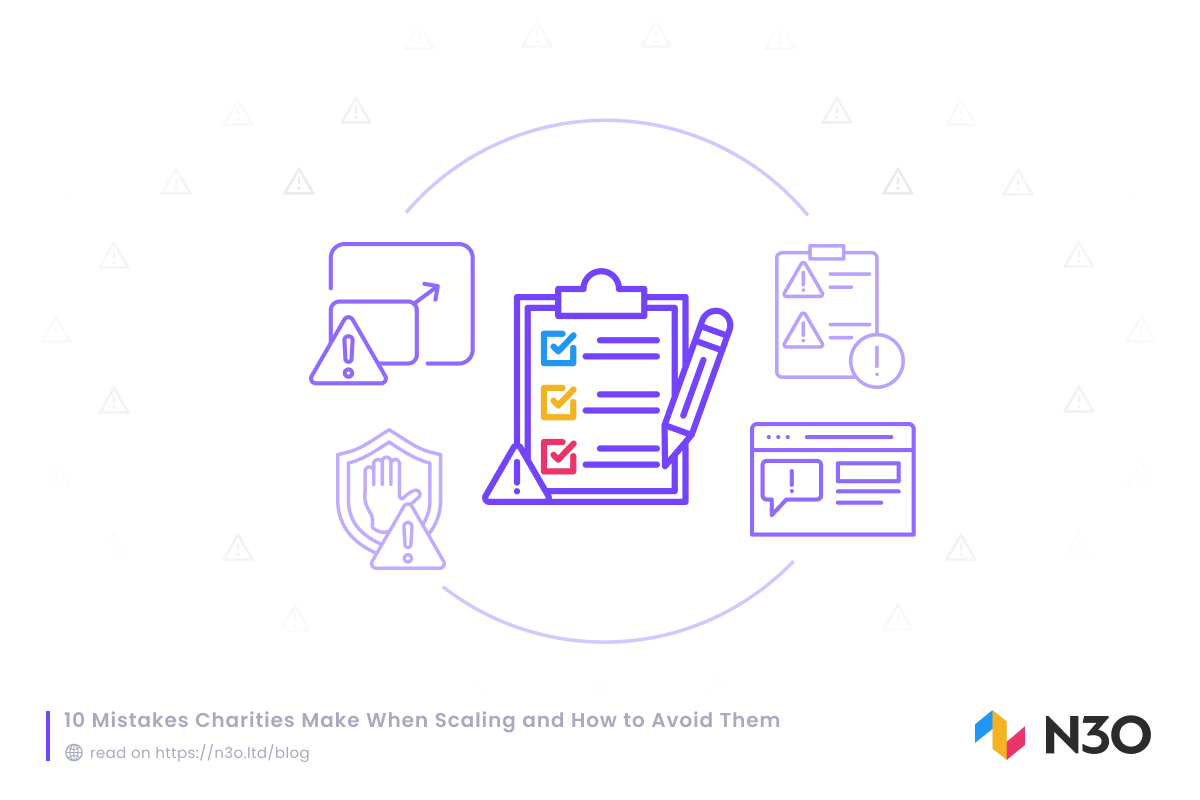
From chasing the wrong funding to outgrowing your tech stack, learn the common mistakes charities make when scaling and how to grow with confidence.
By
Aqsa Deen
・
6
mins read

Scaling is an exciting milestone for any charity. Whether it’s growing from a team of 5 to 50 or crossing the threshold from a six-figure income to a multi-million-pound operation, expansion brings opportunity and risk.
At N3O, we've observed a pattern in our sector experience and through observing charities that have scaled from grassroots to major players in just a few years, where similar mistakes are repeated across different contexts. These mistakes aren’t due to bad intentions; they’re often a byproduct of enthusiasm, urgency, or lack of experience.
In this article, we unpack 10 common mistakes charities make when scaling and offer practical advice, backed by sector insights and research, on how to avoid them.
The Mistake: Many charities accelerate their operations based on new funding or service demands, but they often lack a rigorously designed strategy or metrics framework. This deficiency leads to operational fragmentation and misaligned objectives.
According to a sector-wide study, only 2/3 thirds of nonprofits maintain a current strategic plan. Notably, 90% of high-capacity organisations (those delivering larger-scale impact) have such a plan, compared to just 70% of those with lower capacity. Strategic planning, therefore, is correlated with higher organisational success.
According to the Charity Digital Skills Report 2025, 44% of charities have a digital strategy in place, which has declined from 50% last year. However, just over a third (34%) are advancing with digital.
The Fix: Charities should formalize their vision and measurable goals, using frameworks like Theory of Change, and review strategic alignment periodically. Strategic planning must be a routine (not reactive) activity to foster resilient, opportunity-driven growth.
NPC's "Strategy for Impact" framework is a great starting point. NPC’s guide to creating your theory of change can help you learn more about what ‘Theory of Change’ is and how you can implement it in 10 steps.
The McKinsey 7S Framework is another strong option charities can use. Unlike the Theory of Change (which is impact-focused), the 7S model looks internally at how well the organisation is set up to deliver its mission.
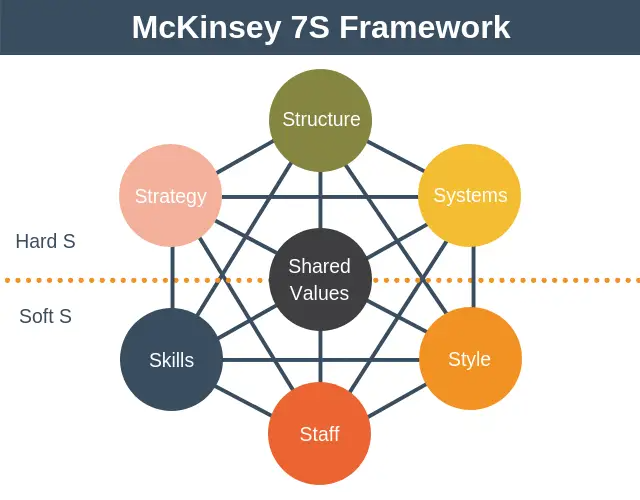
Image Credits: expertprogrammanagement.com
The Mistake: As charities expand, their initial IT systems, often basic tools or free solutions, become inadequate, creating bottlenecks that hinder operational efficiency, accurate reporting, and compliance. This challenge is especially acute for smaller charities, which face disproportionate struggles with IT infrastructure.
According to the Charity Digital Skills Report 2025:
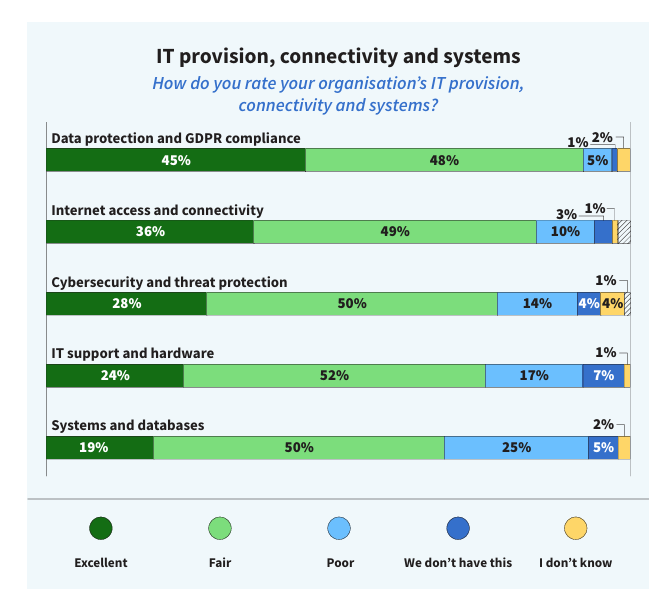
The Fix: Invest in scalable, secure digital tools, including CRM systems and data platforms. Explore grants and industry partnerships to modernize infrastructure, and consider AI adoption carefully, balancing innovation with inclusion and data protection.
The Mistake: Many organisations focus on input/output figures (like total income or number served) but fail to track efficiency, retention, or engagement.
The most effective charities consistently monitor metrics such as donor retention, donation conversion, cost per acquisition, and program efficiency. Donor retention rate, for instance, is critical for sustainable growth and should be tracked monthly using standardized formulas.

The Fix: Develop a KPI dashboard that integrates both operational and impact metrics. Regularly review these indicators at the leadership level to shape decision-making and evidence impact.
The Mistake: Governance models suitable for small charities often break down as complexity increases, leading to confusion, compliance failures, and reputational risks.
According to the NCVO Survey:
The results show that board vacancies have multiple effects on organisations and individuals.

The impact of a trustee vacancy on micro charities (Less than £10,000 income) is even more adverse, as shown by the NCVO Survey:
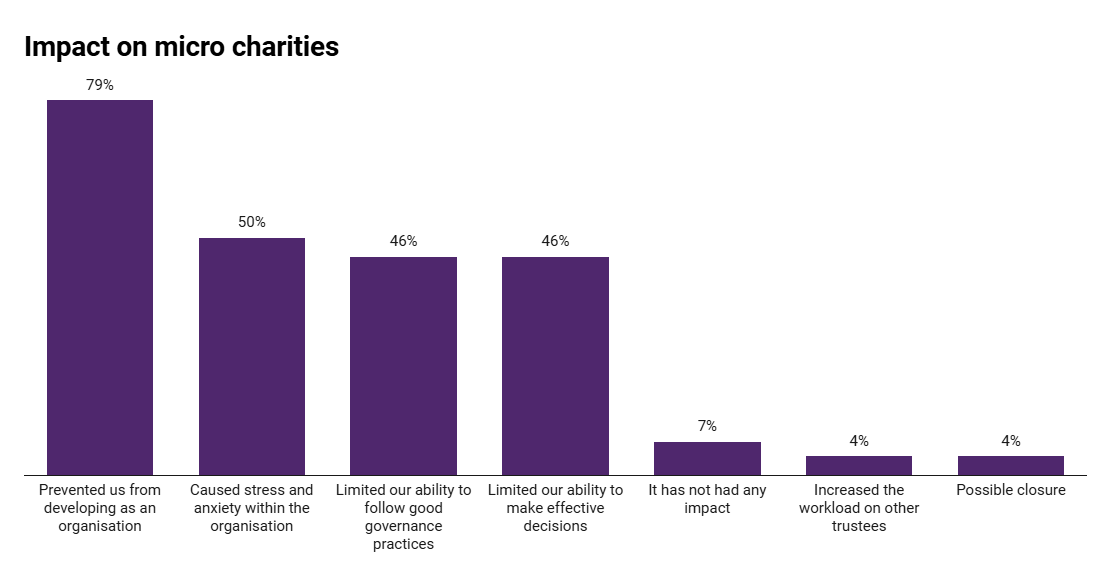
Notably, major scandals in organisations such as The Captain Tom Foundation, Fashion for Relief, and Mermaids have been attributed to underdeveloped governance and blurred trustee-management roles. Sector leaders stress the need for boards to balance oversight with strategic challenge.
Example: A common governance failure happens when trustees, instead of focusing on strategy, oversight, and risk, start making day-to-day management calls (e.g., approving staff rotas, choosing suppliers, or signing off marketing campaigns).
This often arises when the board lacks clarity on its role or when there’s no strong separation of governance and management in the charity’s policies. Staff can become disempowered, unsure whether to follow the CEO’s lead or the trustees’ instructions. It undermines accountability, creates bottlenecks, and can even expose the charity to regulatory scrutiny if trustees neglect their actual oversight duties (like safeguarding, financial risk, and compliance) because they’re too involved in operations.
The Fix: The Charity Commission offers concise, practical guidance to support trustees in fulfilling their duties. These resources are especially useful for new trustees or boards that need a governance refresher.
The NCVO on “Understanding Trustee Recruitment and Retention Challenges” highlights that boards should take a proactive, skills-based approach to trustee recruitment, mapping the competencies needed, advertising widely, and being transparent about the time commitment and responsibilities.
The Mistake: Many charities expand into international territories without first building strong systems, governance, or scalable processes. This often leads to inconsistent donor experiences, compliance risks, and inefficiencies that stall growth abroad.
International expansion commonly exposes charities to compliance failures (e.g., GDPR risks from poor data handling), delays in donor engagement (thank-you letters or allocations missed), and payment barriers (lack of multi-gateway support). Registration with local governing and regulatory bodies can be another major miss. Moreover, running different systems across regions also creates reporting gaps and IT complexity, while weak governance processes leave local teams disconnected from HQ.
The Fix: Charities should prioritise scalable infrastructure before expanding. This includes adopting a robust CRM with multi-currency and compliance capabilities, ensuring consistent systems across regions, and setting clear governance structures (MOUs, DOAs, RACIs). Training local “CRM champions” and holding regular cross-entity check-ins can help maintain oversight and donor trust. With the right digital and governance foundations, expansion becomes sustainable and efficient.
The Mistake: As staff counts grow, communication becomes fragmented, leading to information silos, role confusion, and diluted culture.
As your organisation becomes big, different departments become independent of each other. So, when internal communication breaks down, the impact ripples across an organisation, leading to lower morale, duplicated efforts, and delays in critical work.
For instance, responding to an emergency appeal in a particular territory, like when a natural disaster occurs, requires different departments to come together.
In short, all of the involved stakeholders need to come together to mobilize one project. So, with bigger teams that have a lack of active communication, feedback, updates, and have poor management can create real bottlenecks.
According to the Communication Report 2025 by Axioshq, ineffective communication can cost organisations over 35 lost working days per employee per year, especially among mid-senior professionals. That’s not just lost time, it’s equivalent to over $10,000 in wasted salary per employee annually.
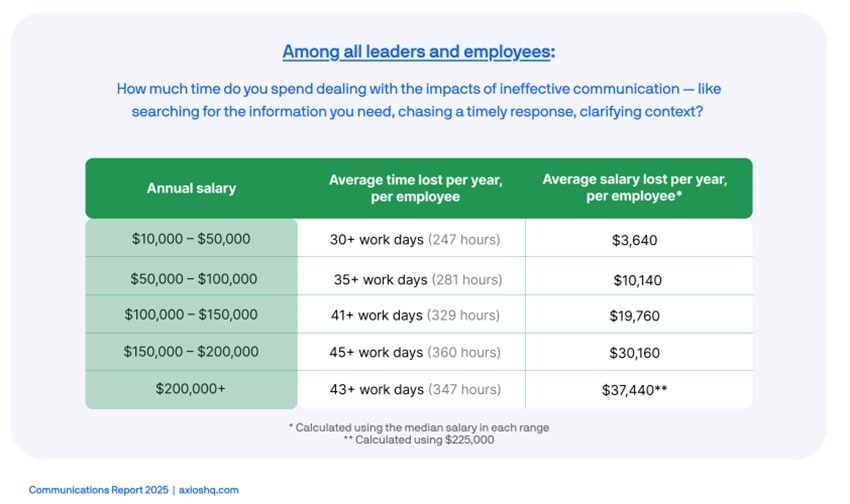
In a sector where every pound or dollar is meant to serve a mission, these inefficiencies are more than operational setbacks; they directly affect the impact delivery.
Investing in internal communications improves employee engagement. 68% of organisations that increased investment in communication saw higher engagement rates, compared to only 32% with flat or reduced investments.
The Fix: Invest in internal comms systems and project management software like Wrike, Monday, leadership training for key management positions, and regular all-team sessions. Codify your values and embed them in every onboarding process.
Establish formal channels (such as all-staff meetings, digital handbooks, and collaboration tools) early in the scaling process. Create feedback loops for staff engagement.
The Mistake: The pressure to grow income often leads charities to chase funding not fully aligned with their original purpose, resulting in grants or contracts outside their core purpose.
Research on resource dependence in nonprofits demonstrates that diversifying funding sources reduces the risk of mission drift. Over-reliance on any one income stream, especially those with restrictive criteria, increases the likelihood of programs shifting away from the core mission.
Another common driver of mission drift is the lack of healthy, unrestricted income. Without flexible resources, leadership struggles to cover essential overheads, strengthen governance, or invest in long-term capacity building. This puts charities in a reactive cycle where funder priorities dictate direction, leaving little room for strategic decision-making, scaling, or innovation. At scale, this weakness magnifies: restricted income may keep programs afloat, but without unrestricted reserves, organisations face governance blind spots, compliance gaps, and vulnerability during financial shocks.
The Fix: Be clear on what you won’t do. Build a fundraising strategy that aligns with your mission and long-term impact. It should define funding that favors unrestricted or values-aligned income. Use a ‘mission filter’ to vet opportunities and regularly communicate organisational boundaries to funders and staff.
The Mistake: In the race to deliver more, developing staff skills often takes a backseat, resulting in underutilized systems, staff disengagement, and low innovation.
In the Charity Digital Skills Report, charities at the Curious stage (with some digital basics in place, such as social media or remote working and see opportunities to do more.), and the Starting out stage (developing their use of digital but don’t yet have a strategic approach) rated themselves as follows in terms of the various skills.

The Charity Digital Skills Report 2025 shows that while many organisations have mastered digital basics—such as social media use, remote working, and data protection—there are significant capability gaps in higher-value areas that drive innovation and long-term efficiency.
At the Curious stage, less than half of charities rate themselves as strong in:
Similarly, those Starting Out with more developed use of digital tools but no clear strategy still show major weaknesses in:
This is not simply a “skills gap” problem; it’s a missed growth opportunity. Digital capabilities such as AI, analytics, SEO, and online fundraising are precisely the levers that allow charities to reach new audiences, streamline operations, and measure impact more effectively. Yet without a deliberate training and development plan, charities risk plateauing in their growth journey.
The Fix: Invest in leadership digital literacy, as Board and CEO digital skills remain low in early-stage charities (Board: 49% at the Curious stage, 45% at Starting Out). Charities can also leverage free and low-cost sector resources like Charity Digital and NCVO to access tailored training pathways. Finally, building a culture of continuous learning by making digital skills a standing agenda item in meetings and encouraging peer-to-peer knowledge sharing ensures adoption becomes embedded.
Bottom line: Investment in skills is an investment in impact.
The Mistake: Many charities push for growth while relying on disjointed systems, manual workarounds, and missing standard operating procedures (SOPs). And expanding results in amplifying these operational risks.
A report by Forward Action found that almost all organisations interviewed use at least nine different digital tools for mobilisation, yet only 16% say these systems integrate well. Over 72% report that poor integration actively hinders their digital activities.
When CRMs lack customisation, require manual processes, and can’t share data smoothly, operational inefficiencies multiply, slowing campaigns, wasting staff time, and obscuring valuable insights. Scaling under these conditions simply magnifies the risks: errors increase, costs rise, and the team becomes bogged down in admin instead of delivering impact.
The Fix: Before scaling, audit and streamline your operational infrastructure. Consolidate platforms where possible to reduce integration friction, and invest in systems that support automation, customisation, and real-time data analysis.
If adopting a charity CRM, make sure to choose one that works best for your organisational needs. Embedding efficient processes and SOPs at this stage ensures growth will amplify impact, not inefficiency.
The Mistake: Too many charities still base strategic choices on assumptions, legacy practices, or gut instinct rather than objective data.
According to the Digital Mobilisation Tech Report, “when asked, 'Who is involved in delivering your digital mobilisation programme?' only 27% of organisations reported having an in-house data analyst. Meanwhile, just 11% outsource data analysis support, meaning at most, only 38% have access to dedicated data expertise.”
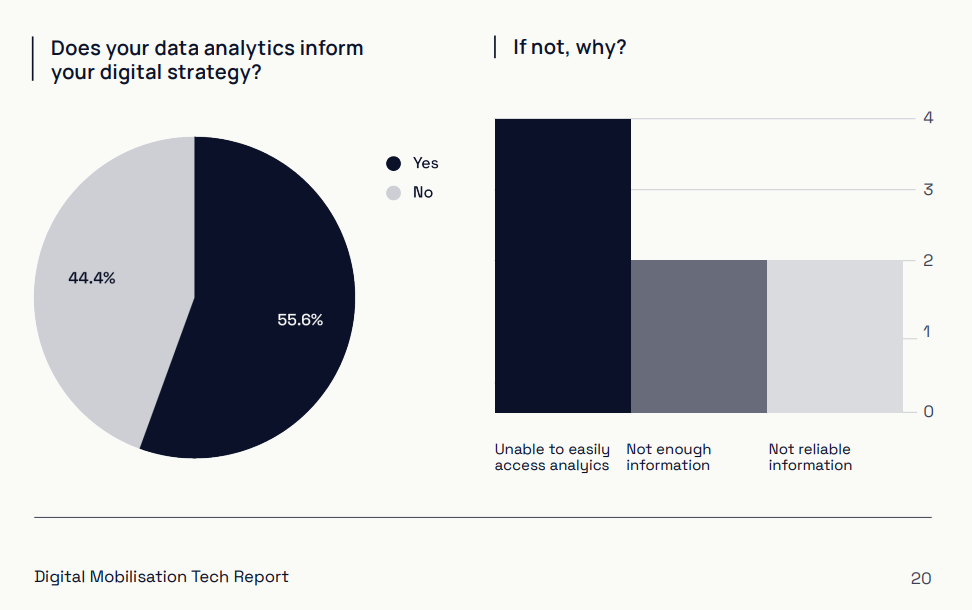
Without skilled analysis, teams struggle to interpret campaign results, adapt strategies, and prove impact to stakeholders. Platform limitations compound this lack of capability: poor integration between tools prevents a holistic view of supporter engagement, while frustrations with GA4 often leave valuable insights untapped.
Some charities are already showing what’s possible by embracing data mining. For instance, large international NGOs often use predictive analytics to identify which donors are most likely to lapse and intervene early with tailored communications. Others analyse supporter behaviour across email, social media, and giving platforms to uncover patterns that guide campaign timing and messaging.
Even smaller charities have started experimenting with heatmaps or A/B testing tools to refine website donation journeys. These examples show that data mining doesn’t have to be complex or expensive - it’s about using the insights you already collect to shape smarter, evidence-based decisions.
The Fix: Treat data as a strategic asset, not an afterthought. Invest in staff training on the analytics tools, ensuring every decision-maker can read and act on data. Build capacity, preferably in-house, to conduct deeper analysis and reporting. Choose technology that supports integrated, actionable insights. And remember: investing in analytics is as vital as investing in campaign creativity, because you can only build on what you can measure.
Build a data-informed & data-centric culture. Invest in analytics platforms to collect, clean, and interpret data, and train staff in data literacy. Make data review an established part of leadership meetings and strategic reviews.
Growth isn’t just about getting bigger, it’s about getting better. By avoiding these common mistakes, charities can build systems, teams, and strategies that keep them aligned with their mission while expanding their impact. Scaling done right means more than sustainability; it means lasting change for the communities you serve.
Get in touch for a demo focused on your charity's needs.